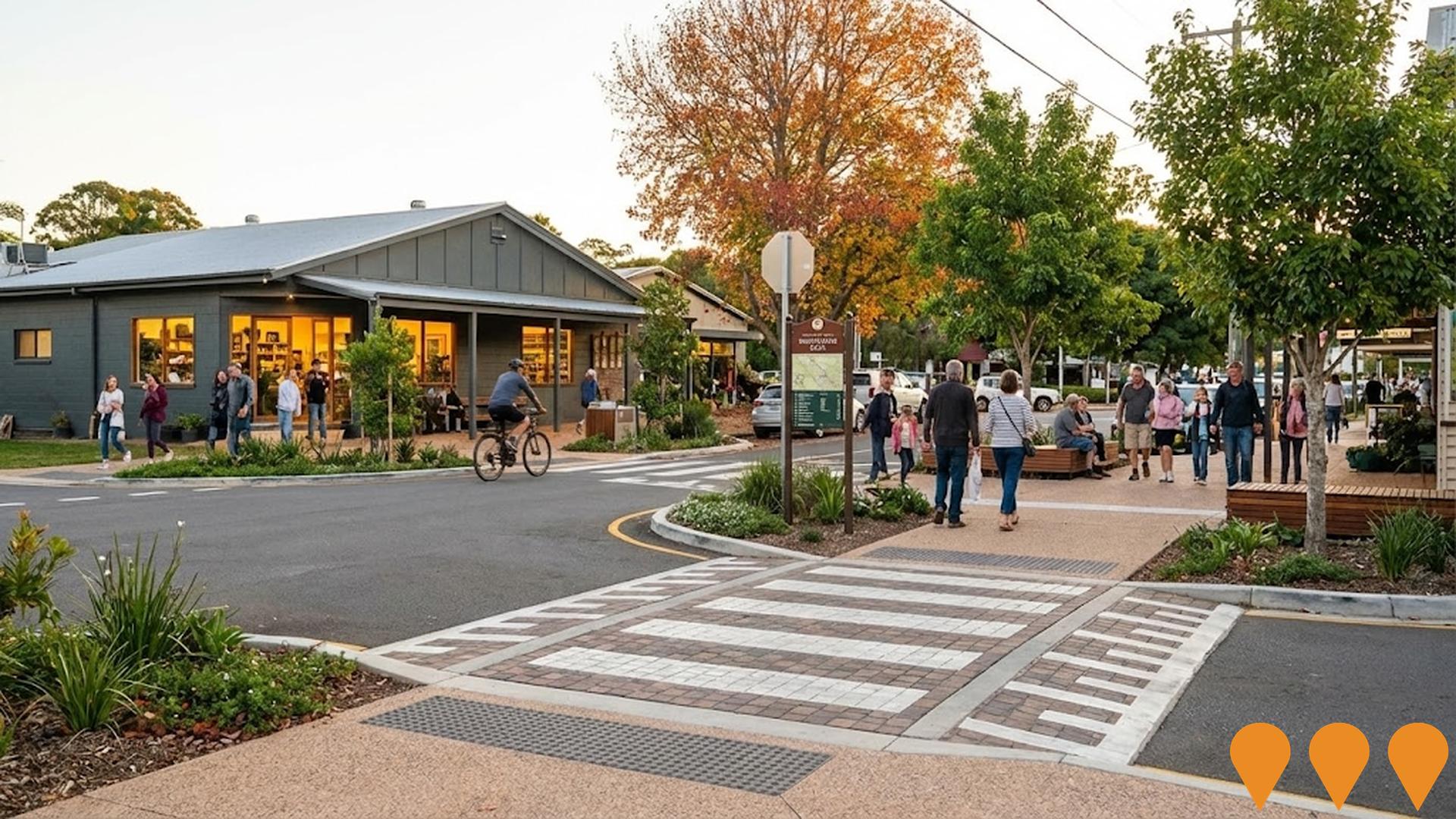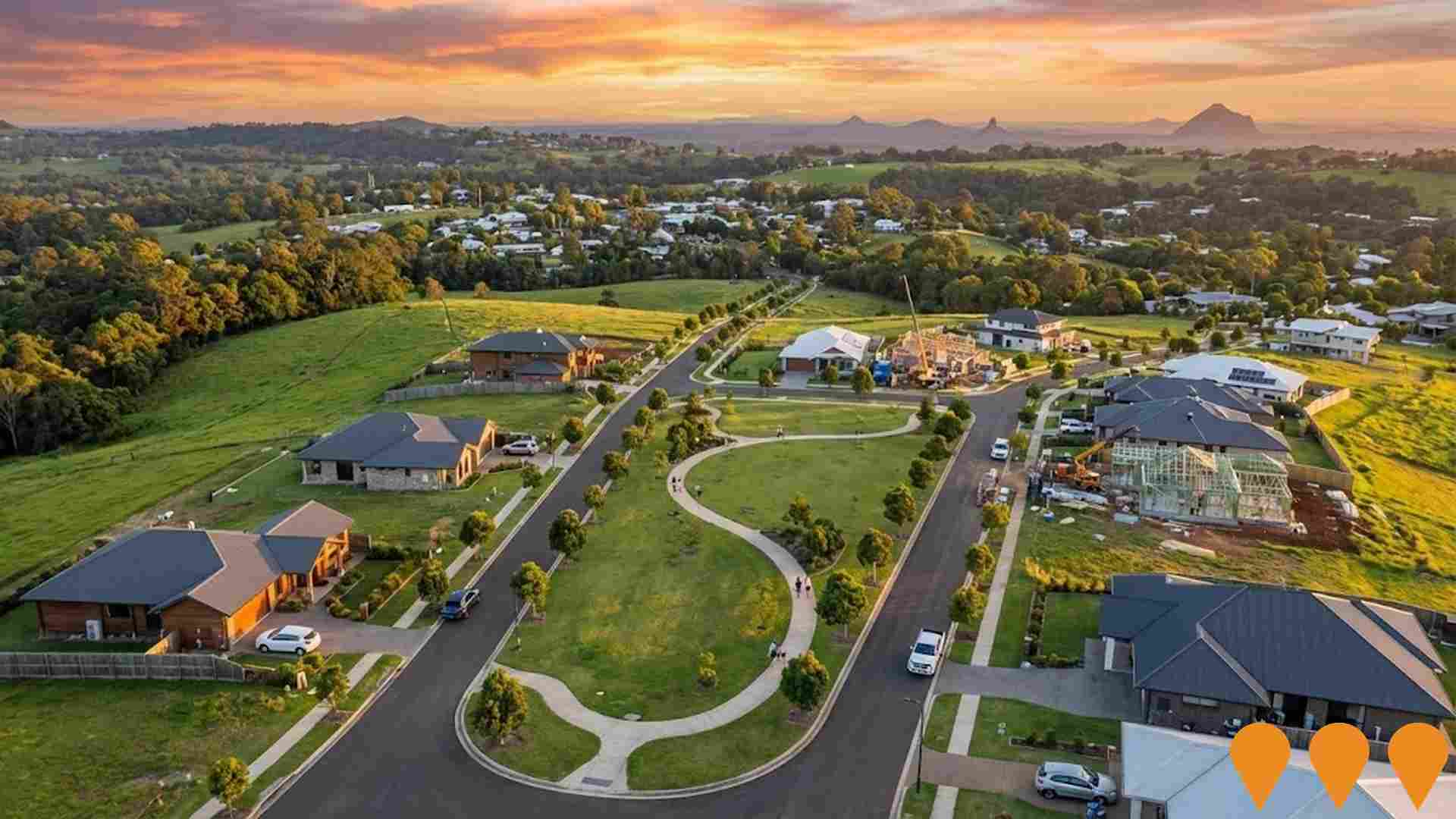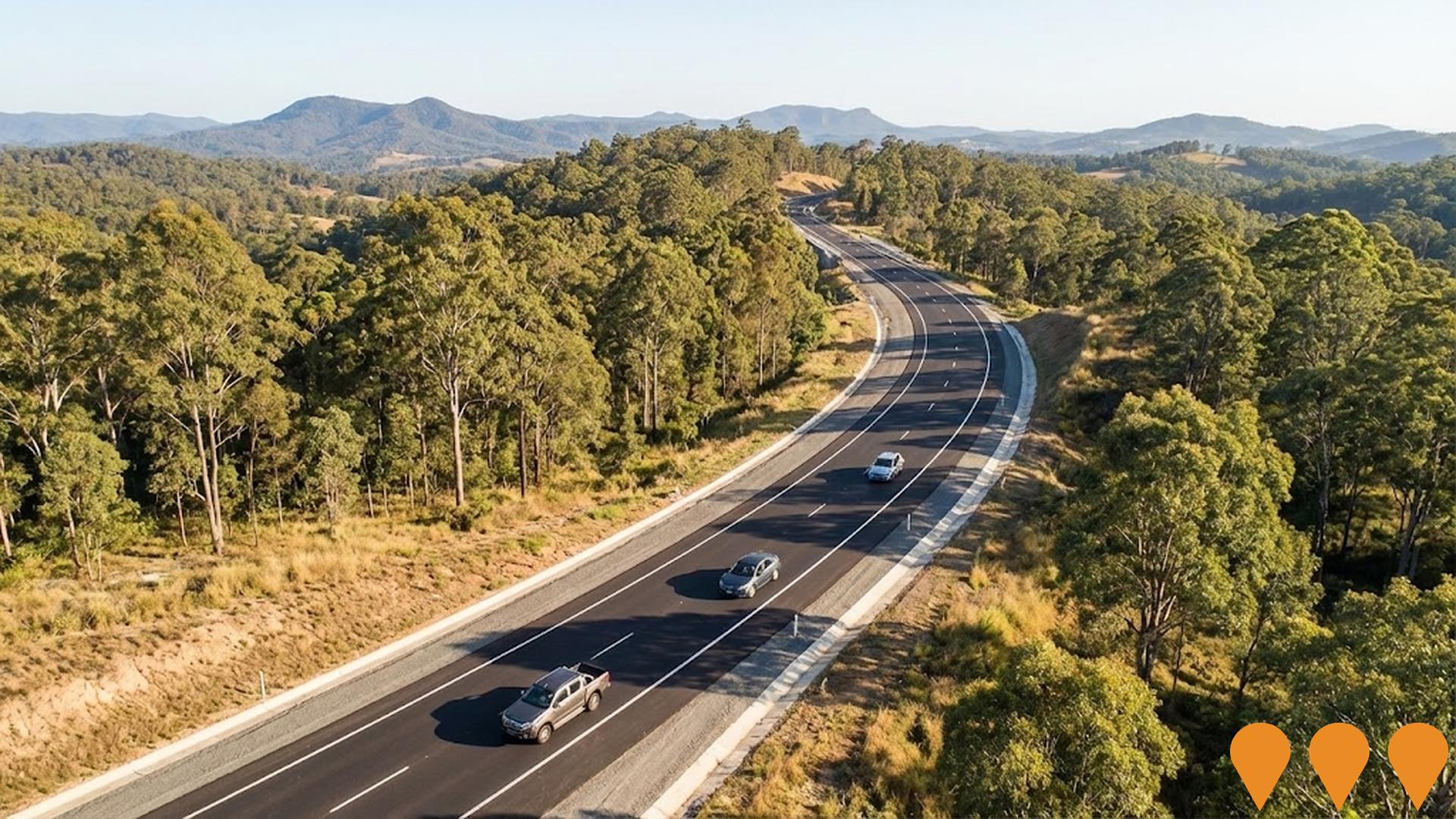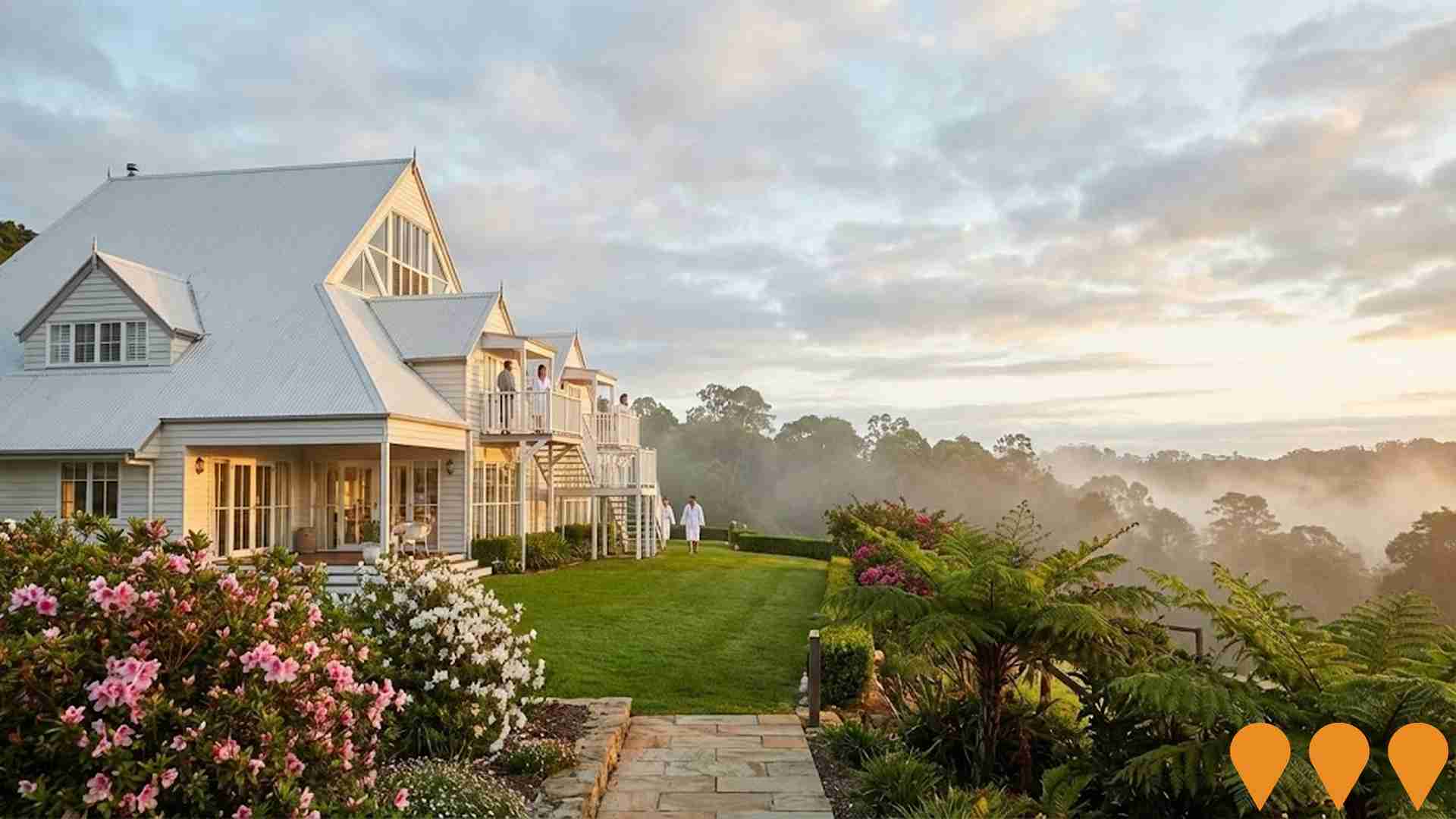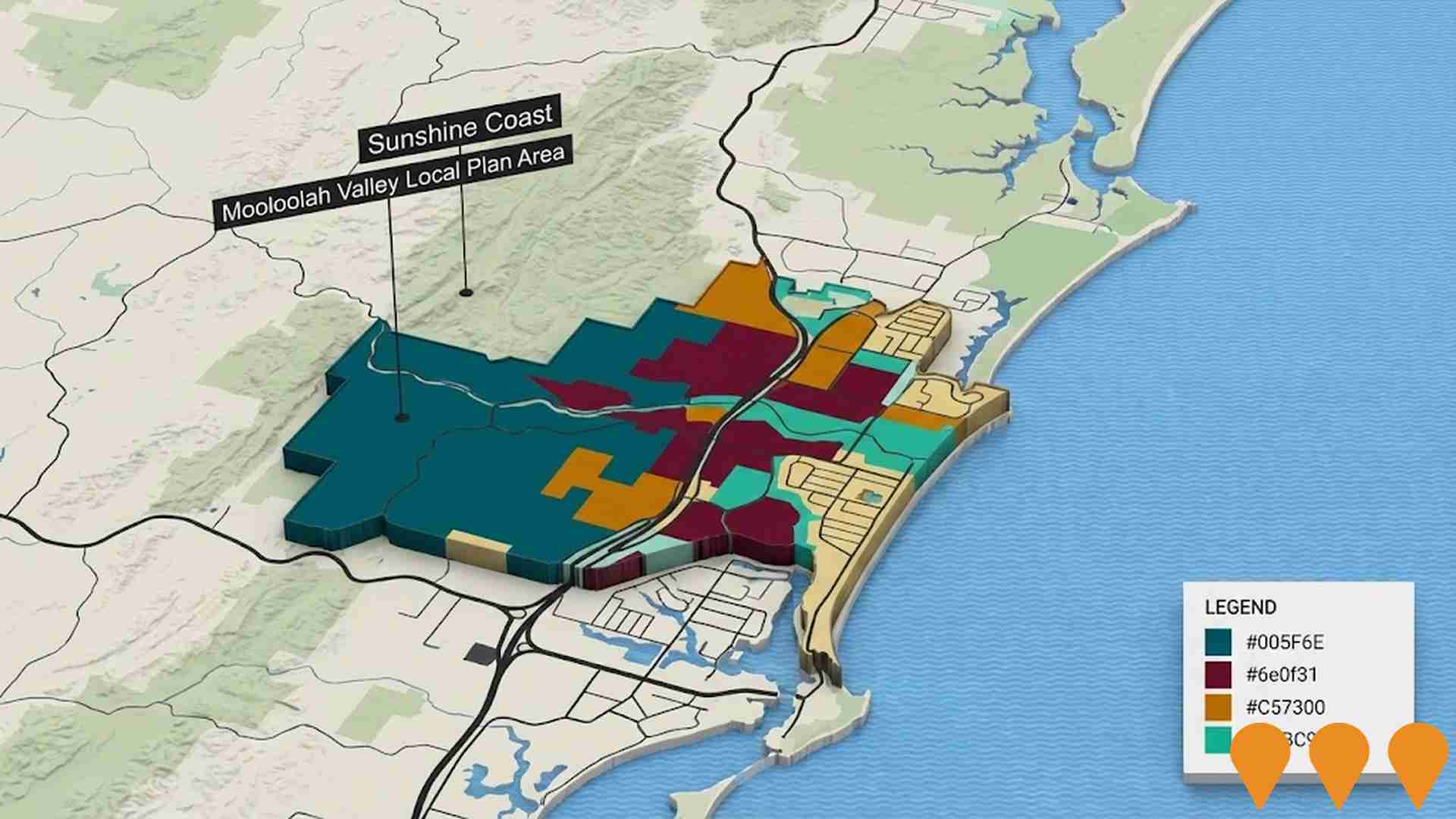Chart Color Schemes
est. as @ -- *
ABS ERP | -- people | --
2021 Census | -- people
Sales Activity
Curious about local property values? Filter the chart to assess the volume and appreciation (including resales) trends and regional comparisons, or scroll to the map below view this information at an individual property level.
Find a Recent Sale
Sales Detail
Population
Caloundra Hinterland has seen population growth performance typically on par with national averages when looking at short and medium term trends
Caloundra Hinterland's population is 9,396 as of November 2025. This figure shows an increase of 286 people since the 2021 Census, which reported a population of 9,110. The change was inferred from ABS estimated resident population of 9,304 in June 2024 and additional validated new addresses since then. This results in a density ratio of 20 persons per square kilometer. Interstate migration contributed approximately 64.4% of overall population gains recently.
AreaSearch uses ABS/Geoscience Australia projections for each SA2 area, released in 2024 with 2022 as the base year. For areas not covered and years post-2032, Queensland State Government's SA2 area projections are adopted, released in 2023 based on 2021 data. These state projections do not provide age category splits; proportional growth weightings from ABS Greater Capital Region projections are applied instead. Future demographic trends anticipate lower quartile growth for Australia's non-metropolitan areas. The area is expected to expand by 69 persons to 2041, reflecting a decline of 0.2% over the 17 years.
Frequently Asked Questions - Population
Development
Recent residential development output has been above average within Caloundra Hinterland when compared nationally
Caloundra Hinterland has recorded approximately 53 residential properties granted approval each year over the past five financial years, totalling 265 homes. In the current financial year FY-26, 29 approvals have been recorded to date. The average number of people moving to the area for each dwelling built over these five years is around 0.8 per year. This indicates that new construction is keeping pace with demand, offering buyers more options and facilitating population growth.
The average expected construction cost value of new properties in the area is approximately $570,000, suggesting developers are targeting the premium market segment. In this financial year, there have been $8.7 million in commercial approvals, indicating limited focus on commercial development compared to residential. Compared to the rest of Queensland, Caloundra Hinterland shows substantially reduced construction activity, with 61.0% below the regional average per person. This limited new supply generally supports stronger demand and values for established properties.
However, building activity has accelerated in recent years, with 81.0% detached houses and 19.0% townhouses or apartments. The location maintains its traditional low density character, appealing to those seeking space and family homes. There are approximately 142 people per dwelling approval in the area, indicating a low density market. Given stable or declining population forecasts, Caloundra Hinterland may experience less housing pressure, creating favourable conditions for buyers.
Frequently Asked Questions - Development
Infrastructure
Caloundra Hinterland has moderate levels of nearby infrastructure activity, ranking in the top 50% nationally
The performance of an area is significantly influenced by changes in local infrastructure, major projects, and planning initiatives. AreaSearch has identified 34 such projects that are likely to impact the area. Notable projects include the Maleny Soldiers Memorial Hospital Upgrade, Maleny Meadows Estate, Landsborough-Maleny Road and Maleny-Montville Road Intersection Upgrade, and Maleny Grove Expansion. The following list details those projects deemed most relevant.
Professional plan users can use the search below to filter and access additional projects.
INFRASTRUCTURE SEARCH
 Denotes AI-based impression for illustrative purposes only, not to be taken as definitive under any circumstances. Please follow links and conduct other investigations from the project's source for actual imagery. Developers and project owners wishing us to use original imagery please Contact Us and we will do so.
Denotes AI-based impression for illustrative purposes only, not to be taken as definitive under any circumstances. Please follow links and conduct other investigations from the project's source for actual imagery. Developers and project owners wishing us to use original imagery please Contact Us and we will do so.
Frequently Asked Questions - Infrastructure
Maleny Soldiers Memorial Hospital Upgrade
A $2.8 million infrastructure upgrade including internal and external works, new mechanical plant, roof, and IT improvements in readiness for the integrated electronic medical records (ieMR) project, intended to enhance patient experience and hospital functionality. External construction started in September 2023, with internal works planned to start in November 2023.
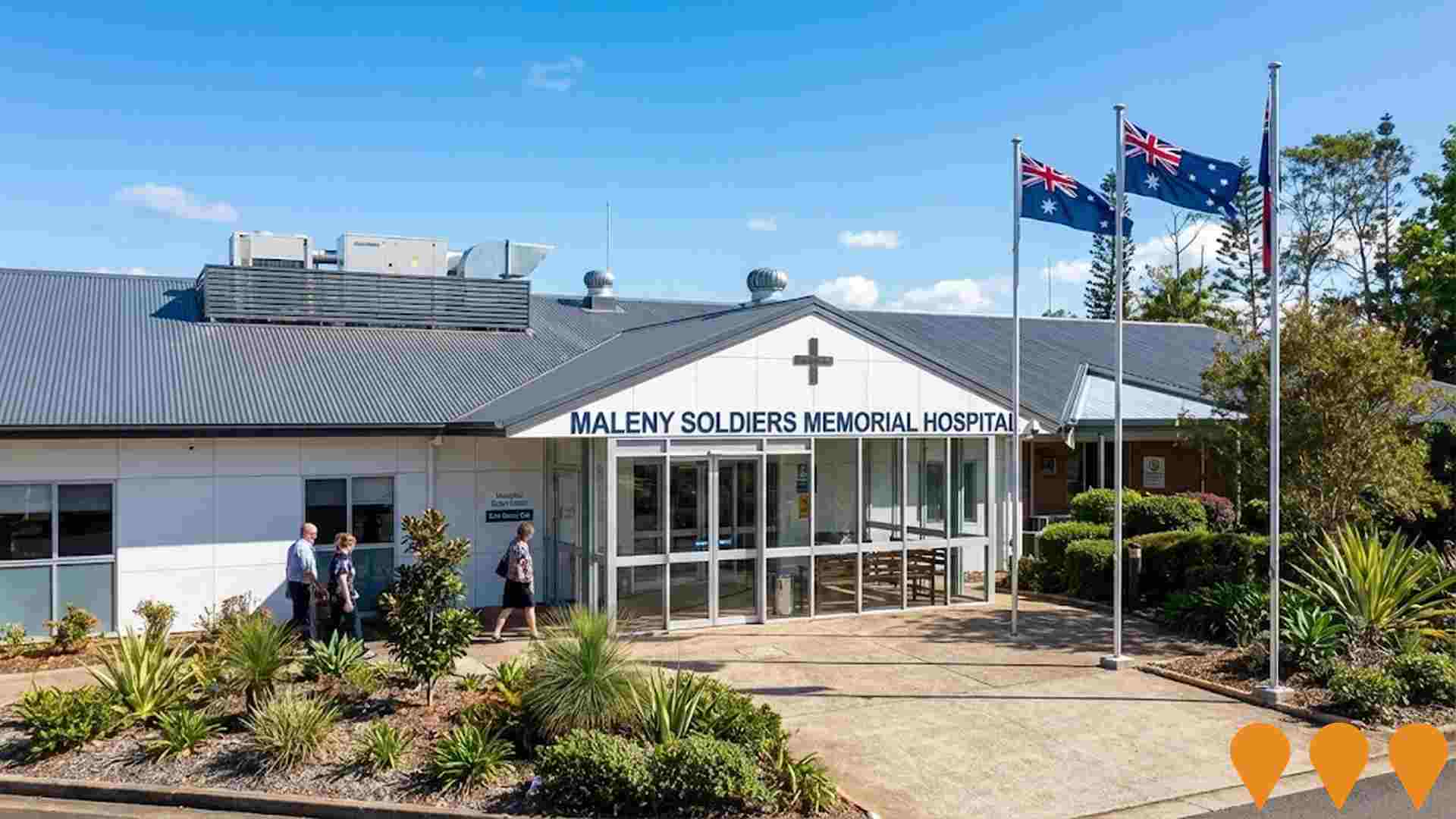
Beerwah Affordable Housing Development
70-unit affordable and social housing complex featuring 58 one-bedroom and 12 two-bedroom units. Located opposite Beerwah railway station. Partnership between Queensland Government and BlueCHP.
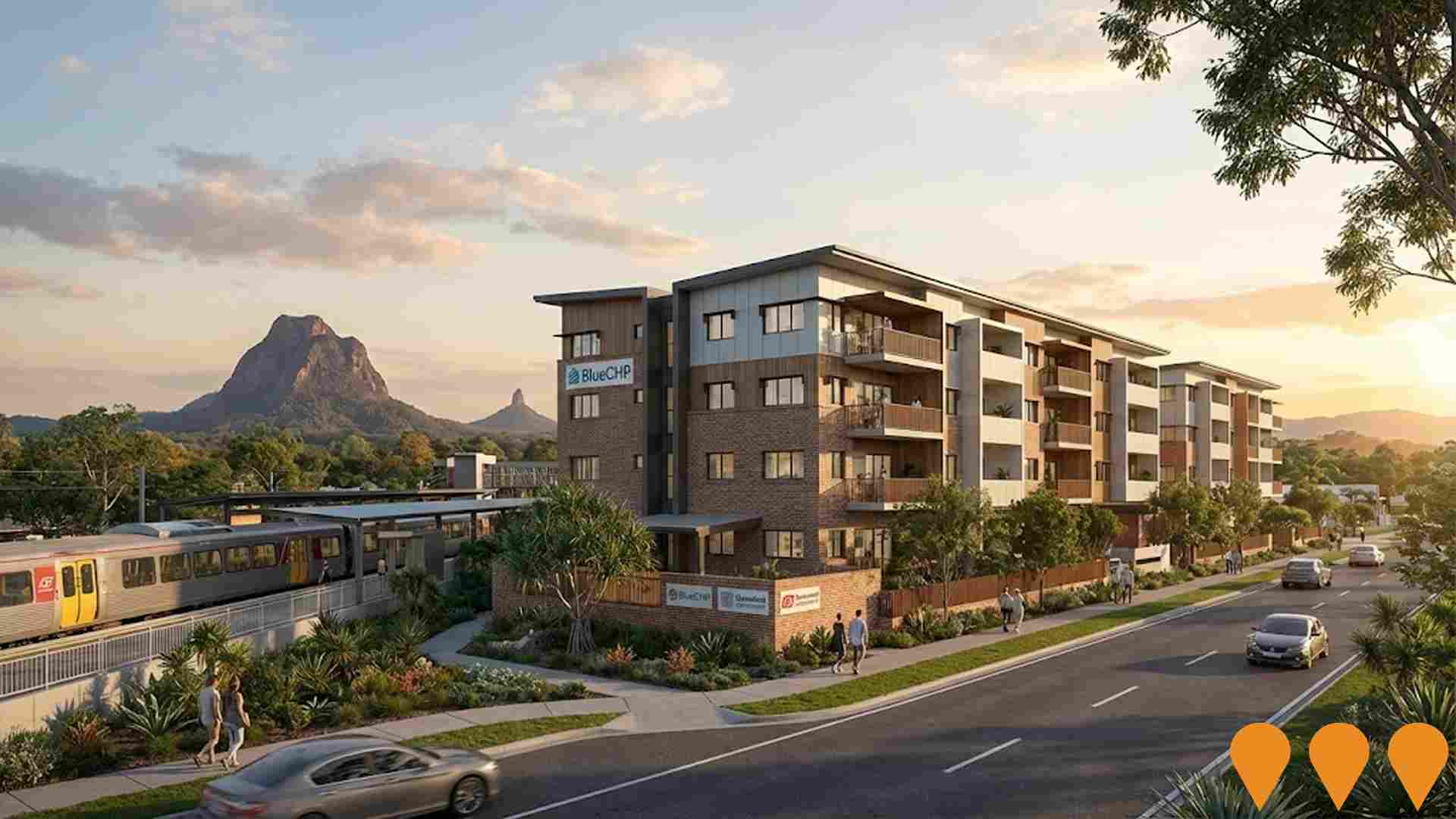
Maleny Meadows Estate
A residential estate in the Sunshine Coast Hinterland offering 32 new homes on elevated allotments from 800m2 to 935m2 with countryside views. The project is nearing completion with civil works underway on the final house and land packages, which are currently for sale.

Vantage Maleny
An over-50s land lease community (formerly Living Gems Maleny) in the Blackall Range, now managed by Vantage by AVID Property Group. The established community offers resort-style amenities including a heated pool, spa, gym, clubhouse, cinema, and a secure, gated living environment for an active, low-maintenance lifestyle.

Upper Obi Obi Creek - Ruddle Drive Project
A multi-stage riparian improvement project involving fencing, off-stream watering, concrete crossings, and weed control to enhance water quality, reduce erosion, and improve habitats in the Obi Obi Creek catchment, a vital part of the water source for Baroon Pocket Dam. The project was planned for the 2022-2023 period and aimed to protect the waterway adjacent to Ruddle Drive.

Hillside Mooloolah Valley
A residential community by Urbex set on approximately 40 hectares in the Sunshine Coast's Mooloolah Valley, featuring 136 large, elevated land lots (710m2 to 1,719m2) with views over nature reserves and hills. The estate offers a blend of coastal and country living and is undergoing a multi-stage development which includes a 3-year revegetation program in partnership with Sunshine Coast Council to enhance environmental health and biodiversity.

Landsborough-Maleny Road and Maleny-Montville Road Intersection Upgrade
A $7 million upgrade to improve safety, efficiency, and capacity at the intersection of Landsborough-Maleny Road and Maleny-Montville Road at Balmoral Ridge. The project was fast-tracked following a serious crash and is part of the 2024 election commitment. Survey works and preliminary investigations are currently underway to identify the most effective intersection configuration and design solution. The upgrade aims to reduce peak hour congestion and improve safety at this busy junction serving the Blackall Range communities.

Coral Residences Maleny
A boutique complex of five modern, three-bedroom townhouses with a DA approval for 5 x duplexes on a 1,014m2 lot. The residences feature open plan living over two levels, modern finishes, and two-car accommodation (garage and carport). Located near Maple Street's cafes, restaurants, markets, and shops, offering a balance of modern living and hinterland charm. They are currently selling off the plan.

Employment
While Caloundra Hinterland retains a healthy unemployment rate of 3.5%, recent employment declines have impacted its national performance ranking
Caloundra Hinterland has a highly educated workforce with strong representation in essential services sectors. Its unemployment rate is 3.5%.
As of June 2025, 4,106 residents are employed, with an unemployment rate of 0.4% below the Rest of Qld's rate of 3.9%. Workforce participation stands at 46.5%, significantly lower than the regional average of 59.1%. Employment is concentrated in health care & social assistance, education & training, and construction. The area shows notable specialization in professional & technical services, with an employment share 1.7 times the regional level.
Conversely, mining has a lower representation at 1.5% compared to the regional average of 3.6%. Labour force levels decreased by 2.2% over the year to June 2025, while employment declined by 0.7%, leading to a fall in unemployment rate by 1.5 percentage points. In contrast, Rest of Qld recorded employment growth of 1.8% and labour force growth of 2.0%, with unemployment rising slightly by 0.2%. Jobs and Skills Australia's national employment forecasts from May 2025 suggest that Caloundra Hinterland's employment could grow by approximately 6.6% over five years and 13.7% over ten years, based on industry-specific projections applied to the local employment mix.
Frequently Asked Questions - Employment
Income
The area's income levels rank in the lower 15% nationally based on AreaSearch comparative data
AreaSearch's aggregation of ATO data for financial year 2022 shows Caloundra Hinterland had a median taxpayer income of $38,255 and an average income of $57,720. Nationally, the median was $50,780 and the average was $64,844. By September 2025, estimated incomes would be approximately $43,607 (median) and $65,795 (average), based on a 13.99% Wage Price Index growth since financial year 2022. The 2021 Census places Caloundra Hinterland's household, family, and personal incomes between the 16th and 18th percentiles nationally. Income distribution shows that 27.7% of locals (2,602 people) earn $800 - 1,499, differing from the regional pattern where $1,500 - 2,999 is dominant at 31.7%. After housing costs, 86.6% of income remains, ranking at the 21st percentile nationally. The area's SEIFA income ranking places it in the 5th decile.
Frequently Asked Questions - Income
Housing
Caloundra Hinterland is characterized by a predominantly suburban housing profile, with above-average rates of outright home ownership
The dwelling structure in Caloundra Hinterland, as per the latest Census data, consisted of 93.3% houses and 6.6% other dwellings such as semi-detached homes, apartments, and 'other' dwellings. This is comparable to Non-Metro Qld's composition of 93.2% houses and 6.7% other dwellings. The home ownership rate in Caloundra Hinterland was higher at 56.0%, with the remaining dwellings either mortgaged (28.0%) or rented (16.0%). The median monthly mortgage repayment in the area was $1,700, lower than Non-Metro Qld's average of $1,863. The median weekly rent figure was recorded at $370, compared to Non-Metro Qld's $400. Nationally, Caloundra Hinterland's mortgage repayments were lower than the Australian average of $1,863, while rents were less than the national figure of $375.
Frequently Asked Questions - Housing
Household Composition
Caloundra Hinterland has a typical household mix, with a lower-than-average median household size
Family households account for 71.5% of all households, consisting of 19.8% couples with children, 40.9% couples without children, and 10.0% single parent families. Non-family households make up the remaining 28.5%, with lone person households at 25.6% and group households comprising 3.0% of the total. The median household size is 2.3 people, which is smaller than the Rest of Qld average of 2.6.
Frequently Asked Questions - Households
Local Schools & Education
The educational profile of Caloundra Hinterland exceeds national averages, with above-average qualification levels and academic performance metrics
Caloundra Hinterland has a notably higher proportion of residents aged 15 and above with university qualifications compared to broader regions. Specifically, 32.0% of its residents hold such qualifications, surpassing the Rest of Qld's 20.6% and the SA3 area's 23.1%. Bachelor degrees are the most common at 20.6%, followed by postgraduate qualifications at 7.4% and graduate diplomas at 4.0%. Vocational credentials are also prominent, with 37.2% of residents holding them, including advanced diplomas (14.4%) and certificates (22.8%).
A significant proportion of the population is actively engaged in formal education, with 23.3% pursuing it, including 7.6% in primary, 7.6% in secondary, and 3.6% in tertiary education. The area's five schools have a combined enrollment of 1,256 students, serving typical Australian school conditions (ICSEA: 1034) with balanced educational opportunities. Education provision is well-balanced with three primary and two secondary schools catering to distinct age groups. School capacity exceeds residential needs, with 13.4 places per 100 residents compared to the regional average of 10.6, indicating that Caloundra Hinterland serves as an educational hub for the broader region.
Frequently Asked Questions - Education
Schools Detail
Nearby Services & Amenities
Transport
Transport servicing is very low compared to other areas nationally based on assessment of service frequency, route connectivity and accessibility
Caloundra Hinterland has 13 operational public transport stops. These are served by buses on two routes, offering a total of 145 weekly passenger trips. Residents' access to transport is limited, with an average distance of 2757 meters to the nearest stop.
Buses run approximately 20 times daily across all routes, equating to about 11 weekly trips per stop.
Frequently Asked Questions - Transport
Transport Stops Detail
Health
Health performance in Caloundra Hinterland is well below average with prevalence of common health conditions notable across both younger and older age cohorts
Caloundra Hinterland faces significant health challenges, with common conditions affecting both younger and older residents. Private health cover is lower than the national average at approximately 49%, covering around 4594 people compared to the national average of 55.3%.
The most prevalent medical conditions are arthritis (11.9%) and mental health issues (8.3%). About 61.3% of residents reported having no medical ailments, compared to 66.4% in the rest of Queensland. The area has a higher proportion of seniors aged 65 and over at 35.1%, with around 3293 people falling into this category, compared to 20.1% in the rest of Queensland. Despite this, health outcomes among seniors are strong and better than those of the general population.
Frequently Asked Questions - Health
Cultural Diversity
Caloundra Hinterland ranks below the Australian average when compared to other local markets across a number of language and cultural background related metrics
Caloundra Hinterland, as per a report dated June 2021, exhibited low cultural diversity with 78.3% of its population born in Australia and 88.2% being citizens. English was the language spoken at home by 95.3% of residents. Christianity was the dominant religion, comprising 41.3% of the population as of June 2021.
Buddhism, however, was overrepresented compared to the rest of Queensland, making up 1.9% versus 1.4%. The top three ancestry groups were English (33.4%), Australian (24.3%), and Irish (11.1%). Notably, Scottish ancestry was higher at 10.2% compared to the regional average of 9.0%, French ancestry stood at 0.8% versus 0.6%, and Welsh ancestry was at 0.8% against a regional average of 0.7%.
Frequently Asked Questions - Diversity
Age
Caloundra Hinterland ranks among the oldest 10% of areas nationwide
The median age in Caloundra Hinterland is 56 years, which is significantly higher than Rest of Qld's average of 41 years and considerably older than the national norm of 38 years. Compared to the Rest of Qld average, the 65-74 cohort is notably over-represented at 19.1% locally, while the 25-34 age group is under-represented at 5.7%. This concentration of the 65-74 cohort is well above the national figure of 9.4%. Between the 2021 Census and present, the 75 to 84 age group has grown from 11.0% to 12.2%, while the 15 to 24 cohort increased from 7.2% to 8.3%. Conversely, the 45 to 54 cohort has declined from 12.8% to 11.5%, and the 65 to 74 group dropped from 20.3% to 19.1%. By 2041, Caloundra Hinterland is expected to see notable shifts in its age composition, with the 85+ age cohort projected to expand considerably by 248 people (71%), from 347 to 596. Notably, the combined 65+ age groups will account for 72% of total population growth, reflecting the area's aging demographic profile. On the other hand, both the 45 to 54 and the 5 to 14 age groups are expected to see reduced numbers.

